Workplace Relationships: Leadership & Management Strategies & Tactics
VerifiedAdded on 2023/06/03
|17
|4329
|51
Report
AI Summary
This report delves into the crucial elements of effective leadership and management, focusing on strategies to enhance workplace relationships and improve overall organizational performance. It begins by emphasizing the importance of strong workplace relationships for boosting morale, productivity, and teamwork, and then explores practical approaches to achieve these goals. The report details the significance of communication and consultation between managers and employees, highlighting how to inform employees about consultation outcomes and avoid misinterpretations. It also examines effective grievance handling procedures for resolving workplace issues and the role of workplace mentoring and counseling in improving employee performance. Furthermore, the report discusses how to build and maintain an ethical workplace culture and the use of interpersonal communication techniques by managers to foster positive relationships. Finally, it proposes an action plan, including policy development, to implement these strategies and concludes with a summary of the key findings and recommendations. The report is supported by relevant research and examples, providing a comprehensive guide for managers seeking to improve their team's dynamics and achieve organizational success.
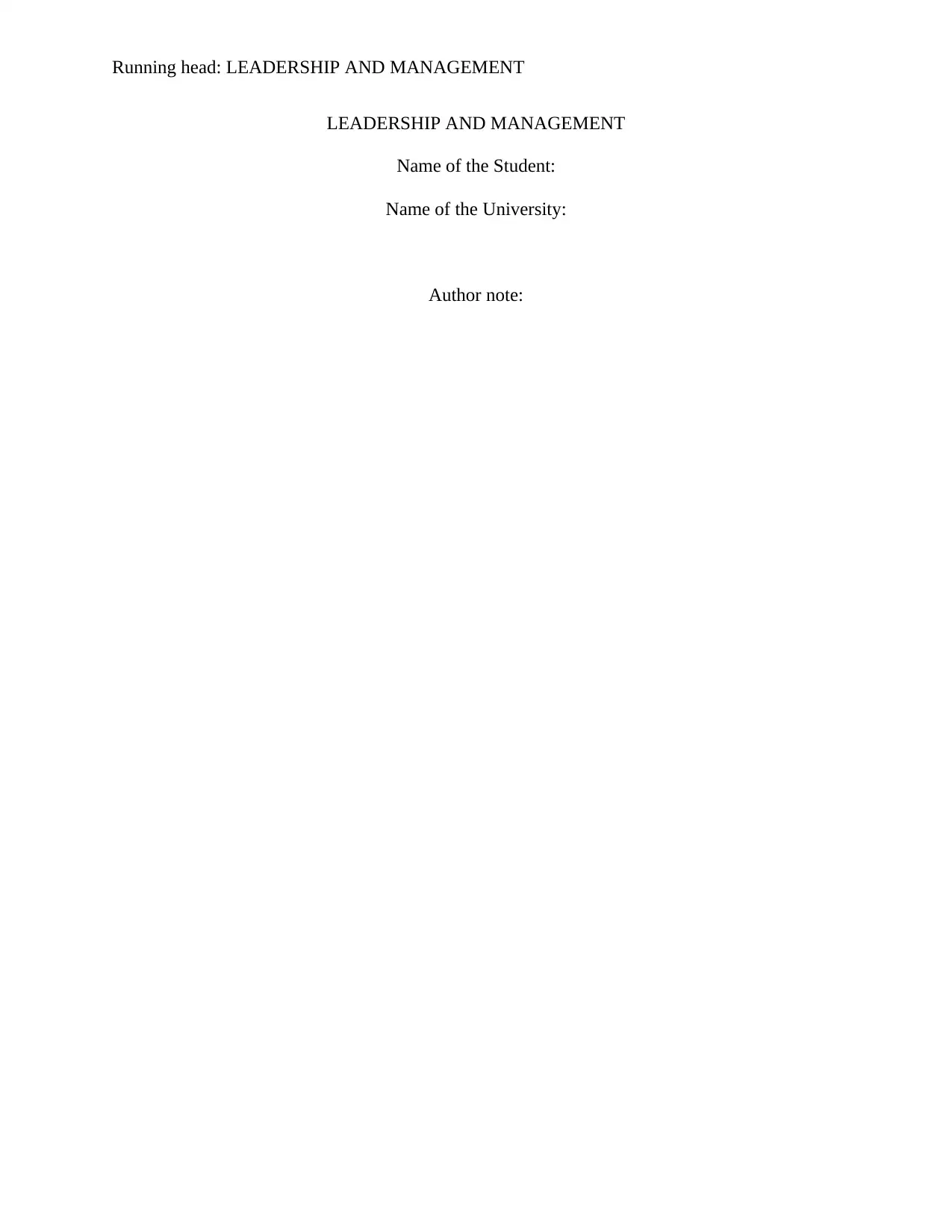
Running head: LEADERSHIP AND MANAGEMENT
LEADERSHIP AND MANAGEMENT
Name of the Student:
Name of the University:
Author note:
LEADERSHIP AND MANAGEMENT
Name of the Student:
Name of the University:
Author note:
Paraphrase This Document
Need a fresh take? Get an instant paraphrase of this document with our AI Paraphraser

1LEADERSHIP AND MANAGEMENT
Executive Summary
Successful organizations are the outcome of effective leadership and management as well as
organizational culture. These vital elements are intrinsically interrelated whereby an organization
will always reveal the values, ideas and beliefs of its founders or managers as they are identified
as the ones accountable for shaping the ethical as well as cultural attributes and traits of the
organization in time. As organizations evolve along with the development of its cultural patterns,
these new cultural patterns tend to shape leaders’ characteristics and further influence his or her
actions in managing the employee base. The paper provided insights into the importance of
consultation and communication between managers and employees to evade any forms of
misinterpretations by shedding light on successful ways of handling employee grievances and
complaints. In addition to this, the paper has evaluated the value of workplace mentoring and
counselling on employee performance and implementation of interpersonal communication
techniques by managers to form effective relationships with employees.
Executive Summary
Successful organizations are the outcome of effective leadership and management as well as
organizational culture. These vital elements are intrinsically interrelated whereby an organization
will always reveal the values, ideas and beliefs of its founders or managers as they are identified
as the ones accountable for shaping the ethical as well as cultural attributes and traits of the
organization in time. As organizations evolve along with the development of its cultural patterns,
these new cultural patterns tend to shape leaders’ characteristics and further influence his or her
actions in managing the employee base. The paper provided insights into the importance of
consultation and communication between managers and employees to evade any forms of
misinterpretations by shedding light on successful ways of handling employee grievances and
complaints. In addition to this, the paper has evaluated the value of workplace mentoring and
counselling on employee performance and implementation of interpersonal communication
techniques by managers to form effective relationships with employees.

2LEADERSHIP AND MANAGEMENT
Table of Contents
Introduction......................................................................................................................................3
Discussion........................................................................................................................................4
Consultation and cooperation in the workplace...........................................................................4
Successful Ways of Handling Employee Grievance...................................................................5
Effectual Ways to Build and Maintain an Ethical Workplace Culture........................................6
Value of Workplace Counselling and Mentoring on Employee Performance............................7
Use of interpersonal communication styles by managers at workplaces....................................8
Developing Policies- Action Plan..............................................................................................11
Conclusion.....................................................................................................................................12
References......................................................................................................................................14
Table of Contents
Introduction......................................................................................................................................3
Discussion........................................................................................................................................4
Consultation and cooperation in the workplace...........................................................................4
Successful Ways of Handling Employee Grievance...................................................................5
Effectual Ways to Build and Maintain an Ethical Workplace Culture........................................6
Value of Workplace Counselling and Mentoring on Employee Performance............................7
Use of interpersonal communication styles by managers at workplaces....................................8
Developing Policies- Action Plan..............................................................................................11
Conclusion.....................................................................................................................................12
References......................................................................................................................................14
⊘ This is a preview!⊘
Do you want full access?
Subscribe today to unlock all pages.

Trusted by 1+ million students worldwide

3LEADERSHIP AND MANAGEMENT
Introduction
Organizations are increasingly identifying factors related to competitiveness which they
must invest in leadership and management development. Over the past decade, organizations and
their leaders have encountered fundamental changes in the workplace that involves rapid
technological transformations, increased globalization along with evolving organizational
structures as well as significant changes in the dynamics of careers (Lefroy et al. 2018). Leaders
and managers in a contemporary business environment are perceived as highly influential groups
to the creation of high-performance organizations. Organizational competence at a management
level at a workplace is considered significant to enhance a higher degree of competitiveness and
ensure potential growth (Uusiautti and Määttä 2018). Modern organizations embracing proactive
and systematic approach towards management and leadership development typically generate
more leadership skills and most active firms are characterized by the intensity and excellence of
their management as well as leadership development interventions. Constructive leadership
development must concentrate on the competencies required to cultivate a vital mission, aim,
purpose and vision of the organization. Any leadership development programme must
fundamentally deal with ways and approaches to develop the identity of the organization and the
workforce and further facilitate to cultivate specific culture required (Babalola et al. 2018).
Leaders and managers will inevitably be entailed in the development and establishment of the
organization, through the means of effective organizational development and design. However, a
crucial part of this procedure involves building a successful team association through the
organization. Thus leadership and management efficacies can radically be enhanced when
leaders can be competent in affecting team development and coaching either by delivering
themselves or bringing external forms of proficiencies when required (Lefroy et al. 2018). The
Introduction
Organizations are increasingly identifying factors related to competitiveness which they
must invest in leadership and management development. Over the past decade, organizations and
their leaders have encountered fundamental changes in the workplace that involves rapid
technological transformations, increased globalization along with evolving organizational
structures as well as significant changes in the dynamics of careers (Lefroy et al. 2018). Leaders
and managers in a contemporary business environment are perceived as highly influential groups
to the creation of high-performance organizations. Organizational competence at a management
level at a workplace is considered significant to enhance a higher degree of competitiveness and
ensure potential growth (Uusiautti and Määttä 2018). Modern organizations embracing proactive
and systematic approach towards management and leadership development typically generate
more leadership skills and most active firms are characterized by the intensity and excellence of
their management as well as leadership development interventions. Constructive leadership
development must concentrate on the competencies required to cultivate a vital mission, aim,
purpose and vision of the organization. Any leadership development programme must
fundamentally deal with ways and approaches to develop the identity of the organization and the
workforce and further facilitate to cultivate specific culture required (Babalola et al. 2018).
Leaders and managers will inevitably be entailed in the development and establishment of the
organization, through the means of effective organizational development and design. However, a
crucial part of this procedure involves building a successful team association through the
organization. Thus leadership and management efficacies can radically be enhanced when
leaders can be competent in affecting team development and coaching either by delivering
themselves or bringing external forms of proficiencies when required (Lefroy et al. 2018). The
Paraphrase This Document
Need a fresh take? Get an instant paraphrase of this document with our AI Paraphraser
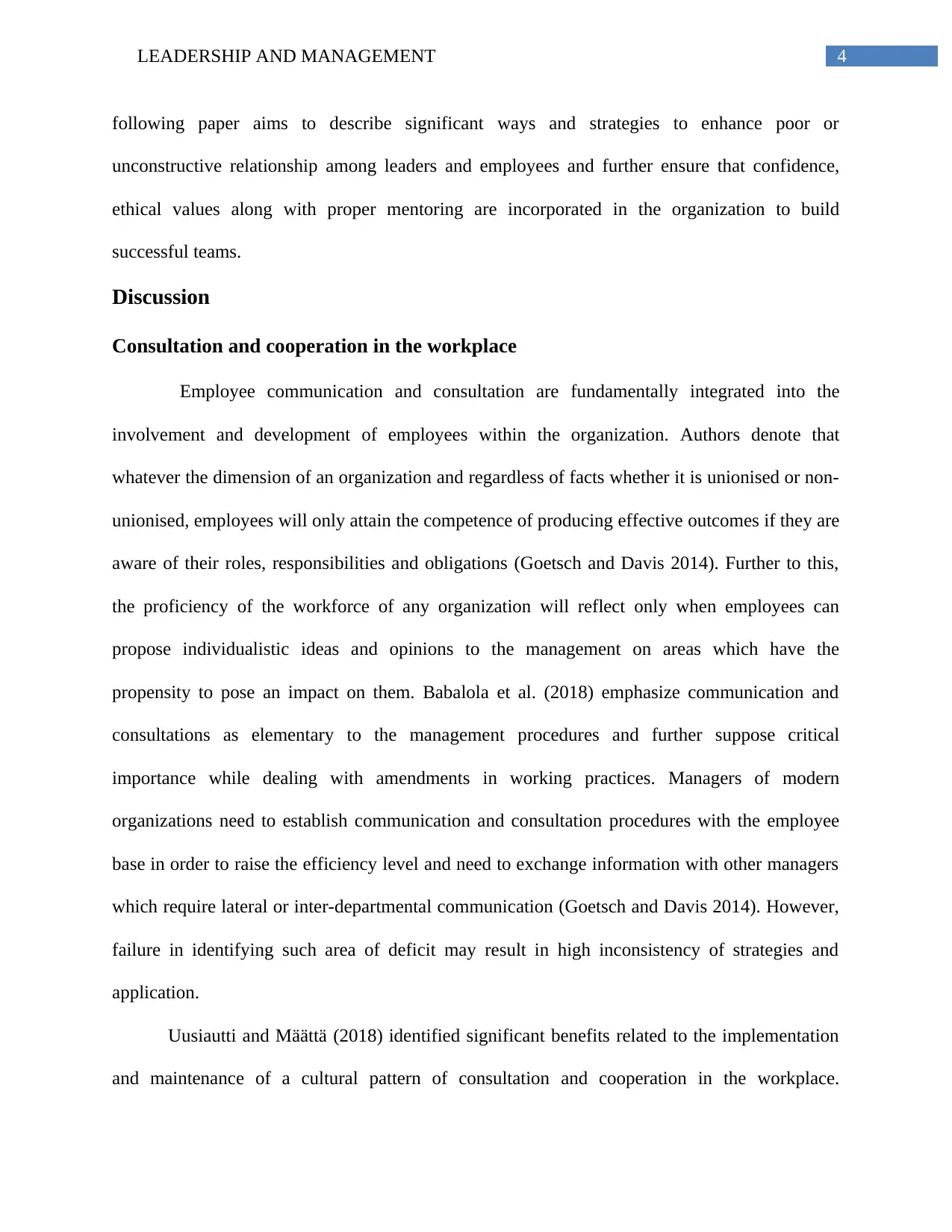
4LEADERSHIP AND MANAGEMENT
following paper aims to describe significant ways and strategies to enhance poor or
unconstructive relationship among leaders and employees and further ensure that confidence,
ethical values along with proper mentoring are incorporated in the organization to build
successful teams.
Discussion
Consultation and cooperation in the workplace
Employee communication and consultation are fundamentally integrated into the
involvement and development of employees within the organization. Authors denote that
whatever the dimension of an organization and regardless of facts whether it is unionised or non-
unionised, employees will only attain the competence of producing effective outcomes if they are
aware of their roles, responsibilities and obligations (Goetsch and Davis 2014). Further to this,
the proficiency of the workforce of any organization will reflect only when employees can
propose individualistic ideas and opinions to the management on areas which have the
propensity to pose an impact on them. Babalola et al. (2018) emphasize communication and
consultations as elementary to the management procedures and further suppose critical
importance while dealing with amendments in working practices. Managers of modern
organizations need to establish communication and consultation procedures with the employee
base in order to raise the efficiency level and need to exchange information with other managers
which require lateral or inter-departmental communication (Goetsch and Davis 2014). However,
failure in identifying such area of deficit may result in high inconsistency of strategies and
application.
Uusiautti and Määttä (2018) identified significant benefits related to the implementation
and maintenance of a cultural pattern of consultation and cooperation in the workplace.
following paper aims to describe significant ways and strategies to enhance poor or
unconstructive relationship among leaders and employees and further ensure that confidence,
ethical values along with proper mentoring are incorporated in the organization to build
successful teams.
Discussion
Consultation and cooperation in the workplace
Employee communication and consultation are fundamentally integrated into the
involvement and development of employees within the organization. Authors denote that
whatever the dimension of an organization and regardless of facts whether it is unionised or non-
unionised, employees will only attain the competence of producing effective outcomes if they are
aware of their roles, responsibilities and obligations (Goetsch and Davis 2014). Further to this,
the proficiency of the workforce of any organization will reflect only when employees can
propose individualistic ideas and opinions to the management on areas which have the
propensity to pose an impact on them. Babalola et al. (2018) emphasize communication and
consultations as elementary to the management procedures and further suppose critical
importance while dealing with amendments in working practices. Managers of modern
organizations need to establish communication and consultation procedures with the employee
base in order to raise the efficiency level and need to exchange information with other managers
which require lateral or inter-departmental communication (Goetsch and Davis 2014). However,
failure in identifying such area of deficit may result in high inconsistency of strategies and
application.
Uusiautti and Määttä (2018) identified significant benefits related to the implementation
and maintenance of a cultural pattern of consultation and cooperation in the workplace.
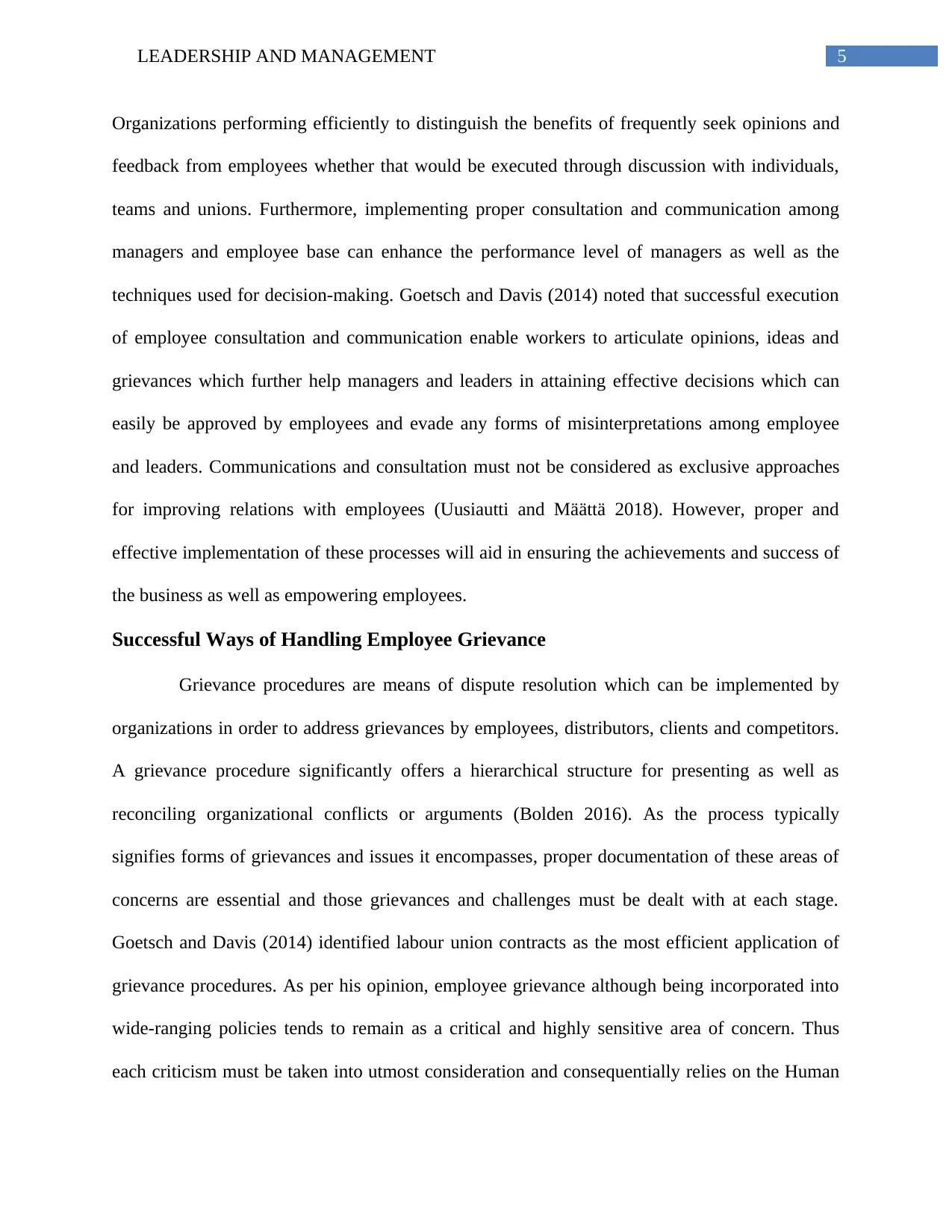
5LEADERSHIP AND MANAGEMENT
Organizations performing efficiently to distinguish the benefits of frequently seek opinions and
feedback from employees whether that would be executed through discussion with individuals,
teams and unions. Furthermore, implementing proper consultation and communication among
managers and employee base can enhance the performance level of managers as well as the
techniques used for decision-making. Goetsch and Davis (2014) noted that successful execution
of employee consultation and communication enable workers to articulate opinions, ideas and
grievances which further help managers and leaders in attaining effective decisions which can
easily be approved by employees and evade any forms of misinterpretations among employee
and leaders. Communications and consultation must not be considered as exclusive approaches
for improving relations with employees (Uusiautti and Määttä 2018). However, proper and
effective implementation of these processes will aid in ensuring the achievements and success of
the business as well as empowering employees.
Successful Ways of Handling Employee Grievance
Grievance procedures are means of dispute resolution which can be implemented by
organizations in order to address grievances by employees, distributors, clients and competitors.
A grievance procedure significantly offers a hierarchical structure for presenting as well as
reconciling organizational conflicts or arguments (Bolden 2016). As the process typically
signifies forms of grievances and issues it encompasses, proper documentation of these areas of
concerns are essential and those grievances and challenges must be dealt with at each stage.
Goetsch and Davis (2014) identified labour union contracts as the most efficient application of
grievance procedures. As per his opinion, employee grievance although being incorporated into
wide-ranging policies tends to remain as a critical and highly sensitive area of concern. Thus
each criticism must be taken into utmost consideration and consequentially relies on the Human
Organizations performing efficiently to distinguish the benefits of frequently seek opinions and
feedback from employees whether that would be executed through discussion with individuals,
teams and unions. Furthermore, implementing proper consultation and communication among
managers and employee base can enhance the performance level of managers as well as the
techniques used for decision-making. Goetsch and Davis (2014) noted that successful execution
of employee consultation and communication enable workers to articulate opinions, ideas and
grievances which further help managers and leaders in attaining effective decisions which can
easily be approved by employees and evade any forms of misinterpretations among employee
and leaders. Communications and consultation must not be considered as exclusive approaches
for improving relations with employees (Uusiautti and Määttä 2018). However, proper and
effective implementation of these processes will aid in ensuring the achievements and success of
the business as well as empowering employees.
Successful Ways of Handling Employee Grievance
Grievance procedures are means of dispute resolution which can be implemented by
organizations in order to address grievances by employees, distributors, clients and competitors.
A grievance procedure significantly offers a hierarchical structure for presenting as well as
reconciling organizational conflicts or arguments (Bolden 2016). As the process typically
signifies forms of grievances and issues it encompasses, proper documentation of these areas of
concerns are essential and those grievances and challenges must be dealt with at each stage.
Goetsch and Davis (2014) identified labour union contracts as the most efficient application of
grievance procedures. As per his opinion, employee grievance although being incorporated into
wide-ranging policies tends to remain as a critical and highly sensitive area of concern. Thus
each criticism must be taken into utmost consideration and consequentially relies on the Human
⊘ This is a preview!⊘
Do you want full access?
Subscribe today to unlock all pages.

Trusted by 1+ million students worldwide
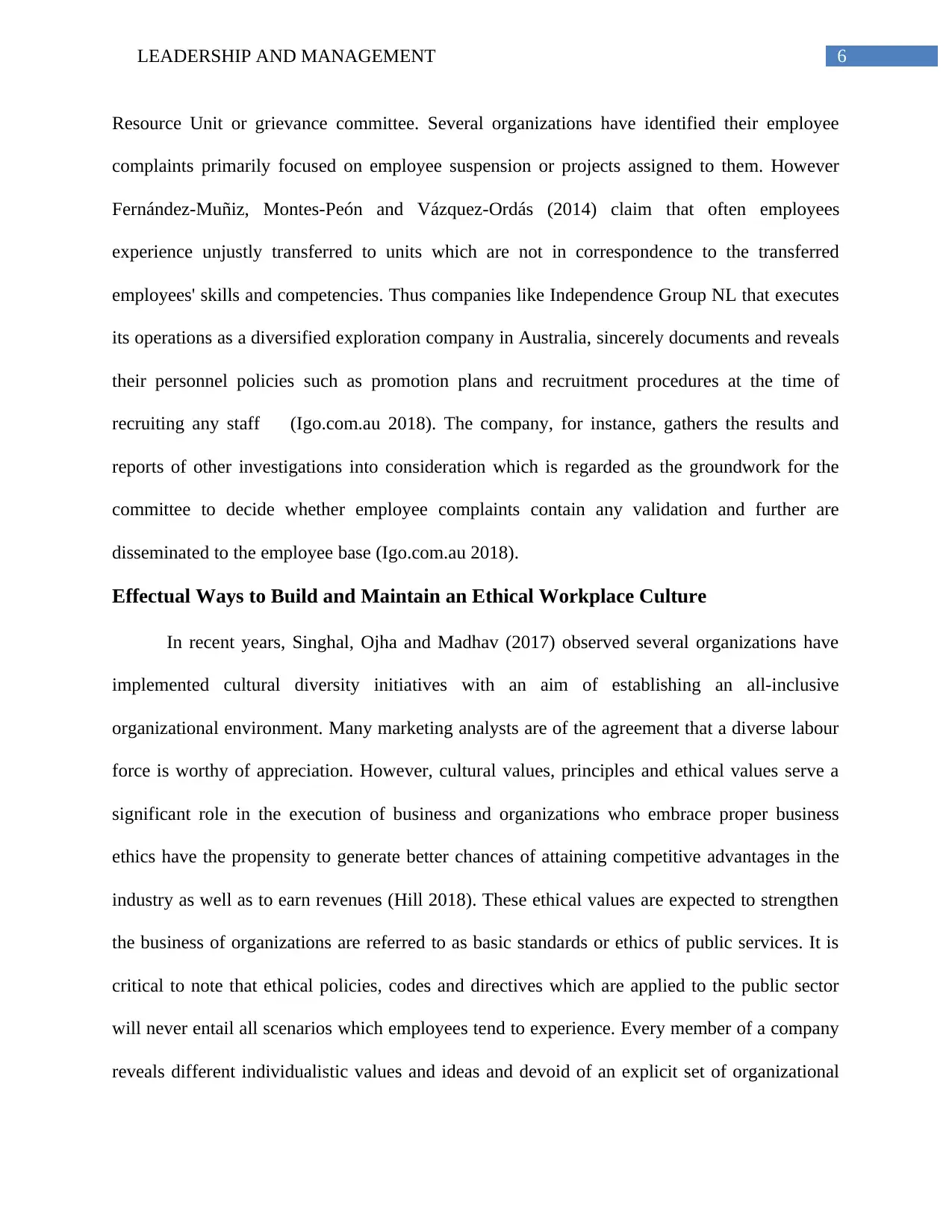
6LEADERSHIP AND MANAGEMENT
Resource Unit or grievance committee. Several organizations have identified their employee
complaints primarily focused on employee suspension or projects assigned to them. However
Fernández-Muñiz, Montes-Peón and Vázquez-Ordás (2014) claim that often employees
experience unjustly transferred to units which are not in correspondence to the transferred
employees' skills and competencies. Thus companies like Independence Group NL that executes
its operations as a diversified exploration company in Australia, sincerely documents and reveals
their personnel policies such as promotion plans and recruitment procedures at the time of
recruiting any staff (Igo.com.au 2018). The company, for instance, gathers the results and
reports of other investigations into consideration which is regarded as the groundwork for the
committee to decide whether employee complaints contain any validation and further are
disseminated to the employee base (Igo.com.au 2018).
Effectual Ways to Build and Maintain an Ethical Workplace Culture
In recent years, Singhal, Ojha and Madhav (2017) observed several organizations have
implemented cultural diversity initiatives with an aim of establishing an all-inclusive
organizational environment. Many marketing analysts are of the agreement that a diverse labour
force is worthy of appreciation. However, cultural values, principles and ethical values serve a
significant role in the execution of business and organizations who embrace proper business
ethics have the propensity to generate better chances of attaining competitive advantages in the
industry as well as to earn revenues (Hill 2018). These ethical values are expected to strengthen
the business of organizations are referred to as basic standards or ethics of public services. It is
critical to note that ethical policies, codes and directives which are applied to the public sector
will never entail all scenarios which employees tend to experience. Every member of a company
reveals different individualistic values and ideas and devoid of an explicit set of organizational
Resource Unit or grievance committee. Several organizations have identified their employee
complaints primarily focused on employee suspension or projects assigned to them. However
Fernández-Muñiz, Montes-Peón and Vázquez-Ordás (2014) claim that often employees
experience unjustly transferred to units which are not in correspondence to the transferred
employees' skills and competencies. Thus companies like Independence Group NL that executes
its operations as a diversified exploration company in Australia, sincerely documents and reveals
their personnel policies such as promotion plans and recruitment procedures at the time of
recruiting any staff (Igo.com.au 2018). The company, for instance, gathers the results and
reports of other investigations into consideration which is regarded as the groundwork for the
committee to decide whether employee complaints contain any validation and further are
disseminated to the employee base (Igo.com.au 2018).
Effectual Ways to Build and Maintain an Ethical Workplace Culture
In recent years, Singhal, Ojha and Madhav (2017) observed several organizations have
implemented cultural diversity initiatives with an aim of establishing an all-inclusive
organizational environment. Many marketing analysts are of the agreement that a diverse labour
force is worthy of appreciation. However, cultural values, principles and ethical values serve a
significant role in the execution of business and organizations who embrace proper business
ethics have the propensity to generate better chances of attaining competitive advantages in the
industry as well as to earn revenues (Hill 2018). These ethical values are expected to strengthen
the business of organizations are referred to as basic standards or ethics of public services. It is
critical to note that ethical policies, codes and directives which are applied to the public sector
will never entail all scenarios which employees tend to experience. Every member of a company
reveals different individualistic values and ideas and devoid of an explicit set of organizational
Paraphrase This Document
Need a fresh take? Get an instant paraphrase of this document with our AI Paraphraser
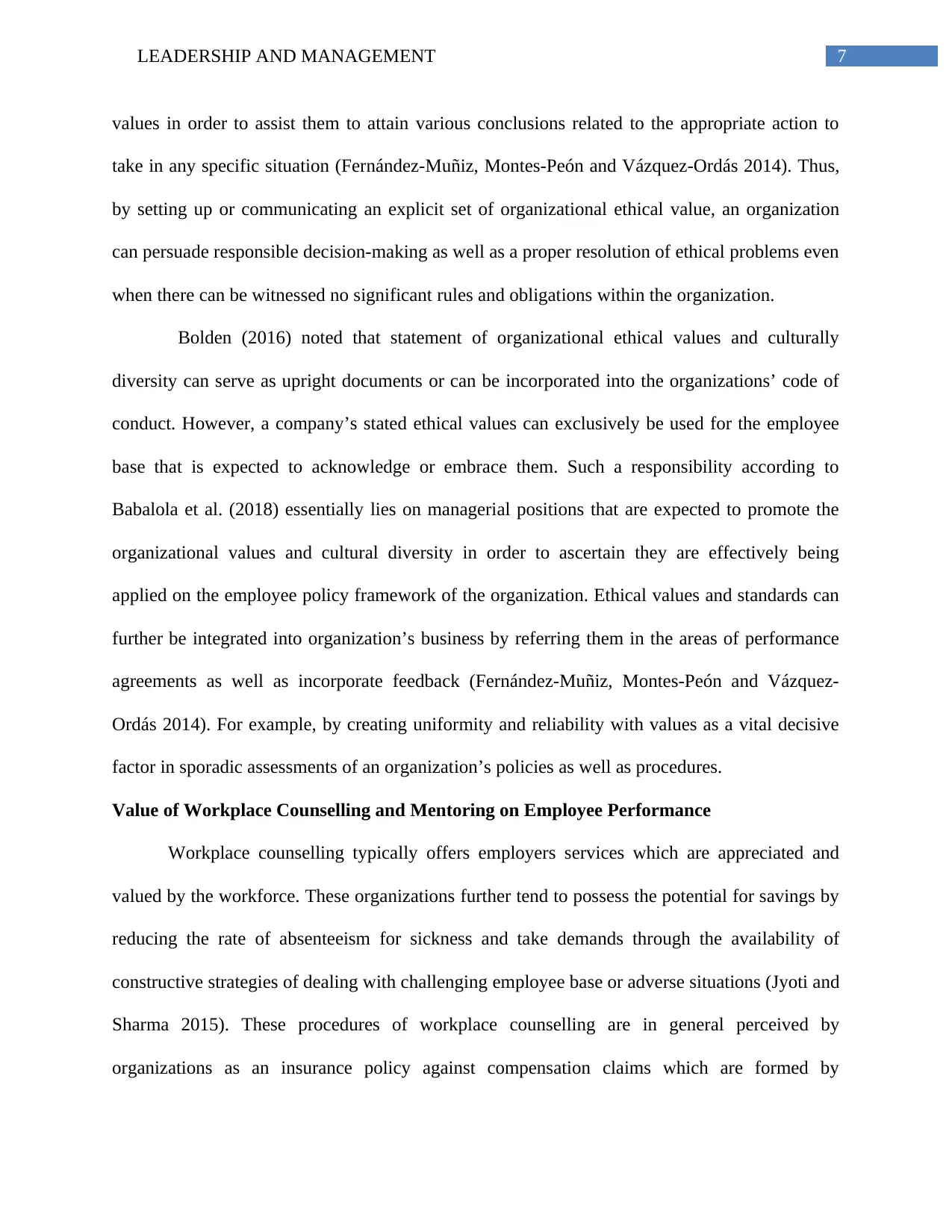
7LEADERSHIP AND MANAGEMENT
values in order to assist them to attain various conclusions related to the appropriate action to
take in any specific situation (Fernández-Muñiz, Montes-Peón and Vázquez-Ordás 2014). Thus,
by setting up or communicating an explicit set of organizational ethical value, an organization
can persuade responsible decision-making as well as a proper resolution of ethical problems even
when there can be witnessed no significant rules and obligations within the organization.
Bolden (2016) noted that statement of organizational ethical values and culturally
diversity can serve as upright documents or can be incorporated into the organizations’ code of
conduct. However, a company’s stated ethical values can exclusively be used for the employee
base that is expected to acknowledge or embrace them. Such a responsibility according to
Babalola et al. (2018) essentially lies on managerial positions that are expected to promote the
organizational values and cultural diversity in order to ascertain they are effectively being
applied on the employee policy framework of the organization. Ethical values and standards can
further be integrated into organization’s business by referring them in the areas of performance
agreements as well as incorporate feedback (Fernández-Muñiz, Montes-Peón and Vázquez-
Ordás 2014). For example, by creating uniformity and reliability with values as a vital decisive
factor in sporadic assessments of an organization’s policies as well as procedures.
Value of Workplace Counselling and Mentoring on Employee Performance
Workplace counselling typically offers employers services which are appreciated and
valued by the workforce. These organizations further tend to possess the potential for savings by
reducing the rate of absenteeism for sickness and take demands through the availability of
constructive strategies of dealing with challenging employee base or adverse situations (Jyoti and
Sharma 2015). These procedures of workplace counselling are in general perceived by
organizations as an insurance policy against compensation claims which are formed by
values in order to assist them to attain various conclusions related to the appropriate action to
take in any specific situation (Fernández-Muñiz, Montes-Peón and Vázquez-Ordás 2014). Thus,
by setting up or communicating an explicit set of organizational ethical value, an organization
can persuade responsible decision-making as well as a proper resolution of ethical problems even
when there can be witnessed no significant rules and obligations within the organization.
Bolden (2016) noted that statement of organizational ethical values and culturally
diversity can serve as upright documents or can be incorporated into the organizations’ code of
conduct. However, a company’s stated ethical values can exclusively be used for the employee
base that is expected to acknowledge or embrace them. Such a responsibility according to
Babalola et al. (2018) essentially lies on managerial positions that are expected to promote the
organizational values and cultural diversity in order to ascertain they are effectively being
applied on the employee policy framework of the organization. Ethical values and standards can
further be integrated into organization’s business by referring them in the areas of performance
agreements as well as incorporate feedback (Fernández-Muñiz, Montes-Peón and Vázquez-
Ordás 2014). For example, by creating uniformity and reliability with values as a vital decisive
factor in sporadic assessments of an organization’s policies as well as procedures.
Value of Workplace Counselling and Mentoring on Employee Performance
Workplace counselling typically offers employers services which are appreciated and
valued by the workforce. These organizations further tend to possess the potential for savings by
reducing the rate of absenteeism for sickness and take demands through the availability of
constructive strategies of dealing with challenging employee base or adverse situations (Jyoti and
Sharma 2015). These procedures of workplace counselling are in general perceived by
organizations as an insurance policy against compensation claims which are formed by
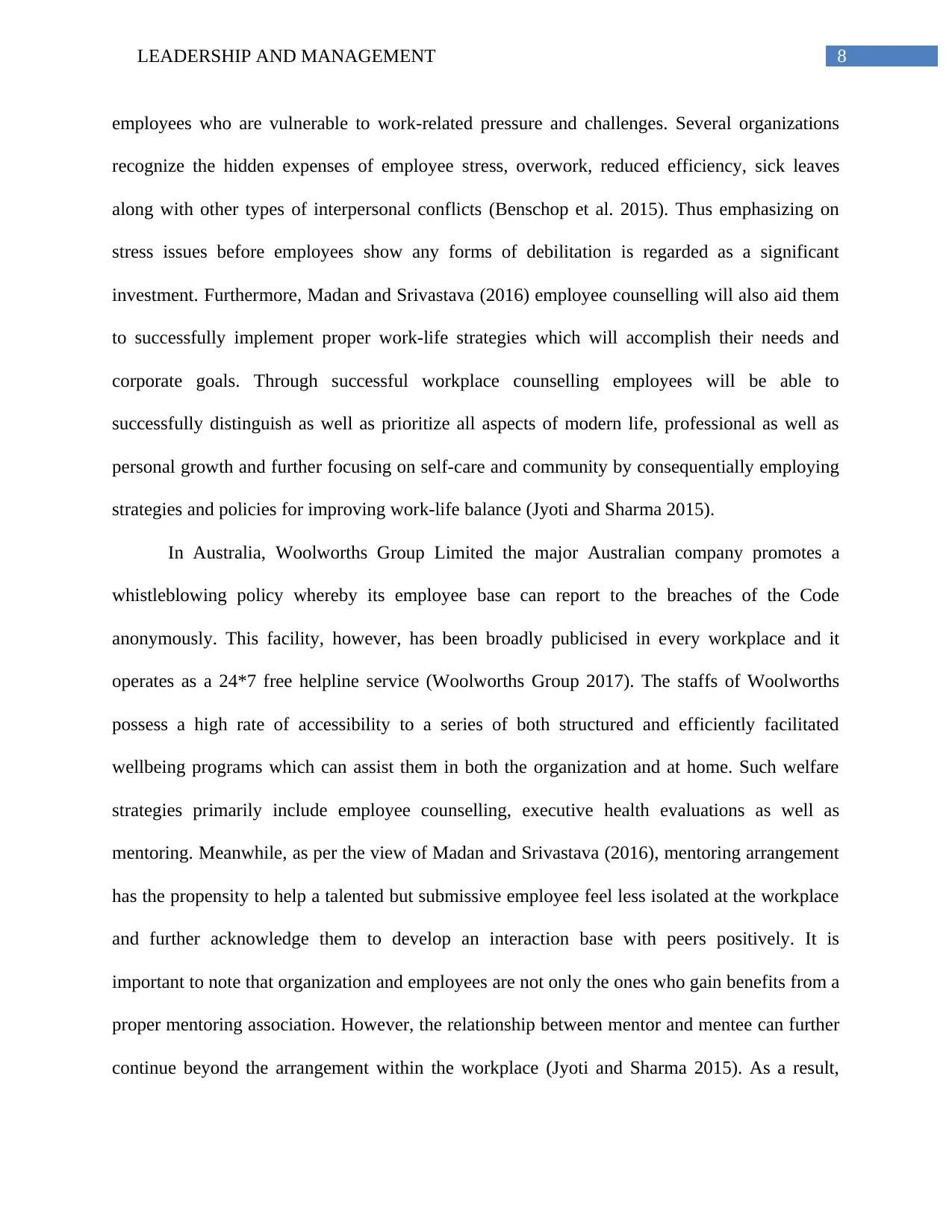
8LEADERSHIP AND MANAGEMENT
employees who are vulnerable to work-related pressure and challenges. Several organizations
recognize the hidden expenses of employee stress, overwork, reduced efficiency, sick leaves
along with other types of interpersonal conflicts (Benschop et al. 2015). Thus emphasizing on
stress issues before employees show any forms of debilitation is regarded as a significant
investment. Furthermore, Madan and Srivastava (2016) employee counselling will also aid them
to successfully implement proper work-life strategies which will accomplish their needs and
corporate goals. Through successful workplace counselling employees will be able to
successfully distinguish as well as prioritize all aspects of modern life, professional as well as
personal growth and further focusing on self-care and community by consequentially employing
strategies and policies for improving work-life balance (Jyoti and Sharma 2015).
In Australia, Woolworths Group Limited the major Australian company promotes a
whistleblowing policy whereby its employee base can report to the breaches of the Code
anonymously. This facility, however, has been broadly publicised in every workplace and it
operates as a 24*7 free helpline service (Woolworths Group 2017). The staffs of Woolworths
possess a high rate of accessibility to a series of both structured and efficiently facilitated
wellbeing programs which can assist them in both the organization and at home. Such welfare
strategies primarily include employee counselling, executive health evaluations as well as
mentoring. Meanwhile, as per the view of Madan and Srivastava (2016), mentoring arrangement
has the propensity to help a talented but submissive employee feel less isolated at the workplace
and further acknowledge them to develop an interaction base with peers positively. It is
important to note that organization and employees are not only the ones who gain benefits from a
proper mentoring association. However, the relationship between mentor and mentee can further
continue beyond the arrangement within the workplace (Jyoti and Sharma 2015). As a result,
employees who are vulnerable to work-related pressure and challenges. Several organizations
recognize the hidden expenses of employee stress, overwork, reduced efficiency, sick leaves
along with other types of interpersonal conflicts (Benschop et al. 2015). Thus emphasizing on
stress issues before employees show any forms of debilitation is regarded as a significant
investment. Furthermore, Madan and Srivastava (2016) employee counselling will also aid them
to successfully implement proper work-life strategies which will accomplish their needs and
corporate goals. Through successful workplace counselling employees will be able to
successfully distinguish as well as prioritize all aspects of modern life, professional as well as
personal growth and further focusing on self-care and community by consequentially employing
strategies and policies for improving work-life balance (Jyoti and Sharma 2015).
In Australia, Woolworths Group Limited the major Australian company promotes a
whistleblowing policy whereby its employee base can report to the breaches of the Code
anonymously. This facility, however, has been broadly publicised in every workplace and it
operates as a 24*7 free helpline service (Woolworths Group 2017). The staffs of Woolworths
possess a high rate of accessibility to a series of both structured and efficiently facilitated
wellbeing programs which can assist them in both the organization and at home. Such welfare
strategies primarily include employee counselling, executive health evaluations as well as
mentoring. Meanwhile, as per the view of Madan and Srivastava (2016), mentoring arrangement
has the propensity to help a talented but submissive employee feel less isolated at the workplace
and further acknowledge them to develop an interaction base with peers positively. It is
important to note that organization and employees are not only the ones who gain benefits from a
proper mentoring association. However, the relationship between mentor and mentee can further
continue beyond the arrangement within the workplace (Jyoti and Sharma 2015). As a result,
⊘ This is a preview!⊘
Do you want full access?
Subscribe today to unlock all pages.

Trusted by 1+ million students worldwide
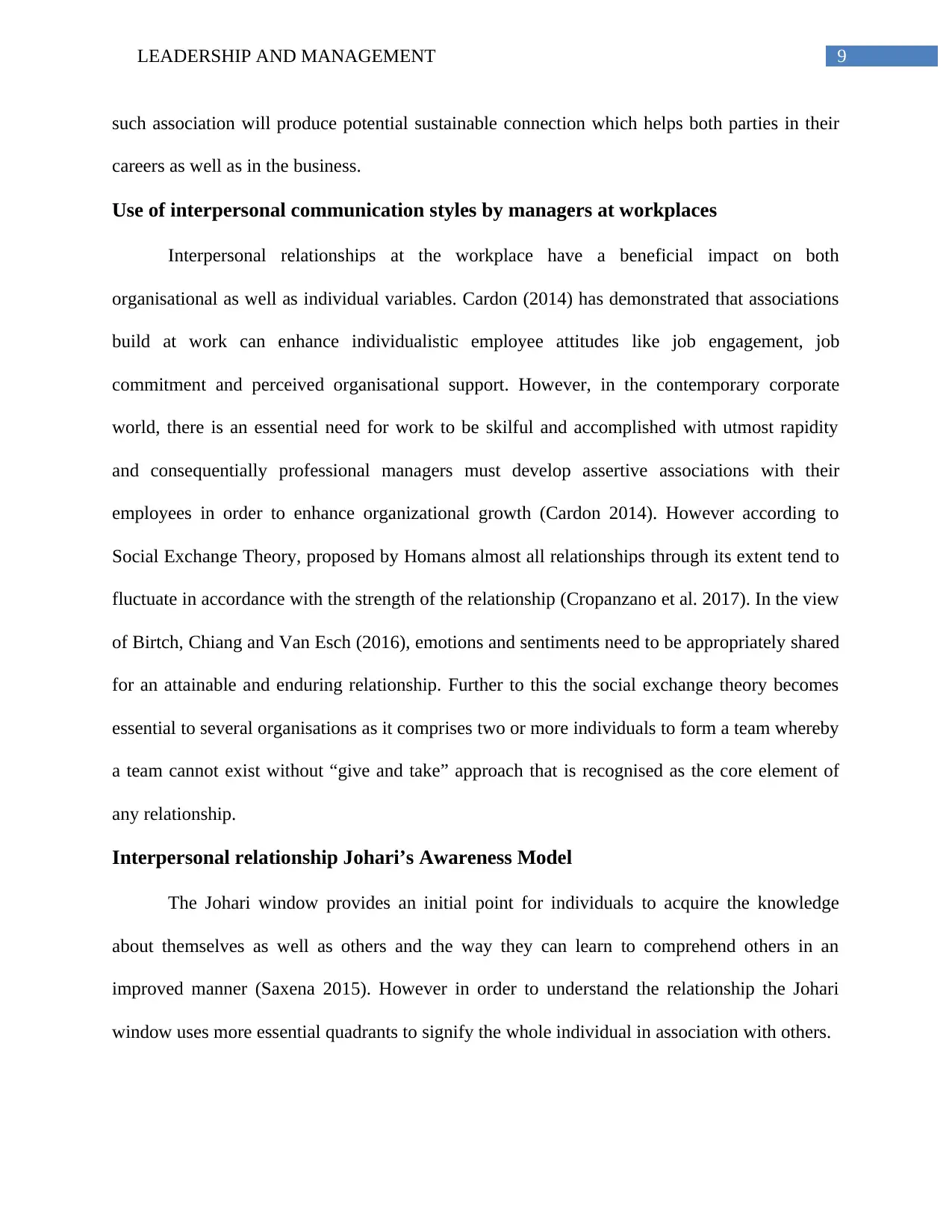
9LEADERSHIP AND MANAGEMENT
such association will produce potential sustainable connection which helps both parties in their
careers as well as in the business.
Use of interpersonal communication styles by managers at workplaces
Interpersonal relationships at the workplace have a beneficial impact on both
organisational as well as individual variables. Cardon (2014) has demonstrated that associations
build at work can enhance individualistic employee attitudes like job engagement, job
commitment and perceived organisational support. However, in the contemporary corporate
world, there is an essential need for work to be skilful and accomplished with utmost rapidity
and consequentially professional managers must develop assertive associations with their
employees in order to enhance organizational growth (Cardon 2014). However according to
Social Exchange Theory, proposed by Homans almost all relationships through its extent tend to
fluctuate in accordance with the strength of the relationship (Cropanzano et al. 2017). In the view
of Birtch, Chiang and Van Esch (2016), emotions and sentiments need to be appropriately shared
for an attainable and enduring relationship. Further to this the social exchange theory becomes
essential to several organisations as it comprises two or more individuals to form a team whereby
a team cannot exist without “give and take” approach that is recognised as the core element of
any relationship.
Interpersonal relationship Johari’s Awareness Model
The Johari window provides an initial point for individuals to acquire the knowledge
about themselves as well as others and the way they can learn to comprehend others in an
improved manner (Saxena 2015). However in order to understand the relationship the Johari
window uses more essential quadrants to signify the whole individual in association with others.
such association will produce potential sustainable connection which helps both parties in their
careers as well as in the business.
Use of interpersonal communication styles by managers at workplaces
Interpersonal relationships at the workplace have a beneficial impact on both
organisational as well as individual variables. Cardon (2014) has demonstrated that associations
build at work can enhance individualistic employee attitudes like job engagement, job
commitment and perceived organisational support. However, in the contemporary corporate
world, there is an essential need for work to be skilful and accomplished with utmost rapidity
and consequentially professional managers must develop assertive associations with their
employees in order to enhance organizational growth (Cardon 2014). However according to
Social Exchange Theory, proposed by Homans almost all relationships through its extent tend to
fluctuate in accordance with the strength of the relationship (Cropanzano et al. 2017). In the view
of Birtch, Chiang and Van Esch (2016), emotions and sentiments need to be appropriately shared
for an attainable and enduring relationship. Further to this the social exchange theory becomes
essential to several organisations as it comprises two or more individuals to form a team whereby
a team cannot exist without “give and take” approach that is recognised as the core element of
any relationship.
Interpersonal relationship Johari’s Awareness Model
The Johari window provides an initial point for individuals to acquire the knowledge
about themselves as well as others and the way they can learn to comprehend others in an
improved manner (Saxena 2015). However in order to understand the relationship the Johari
window uses more essential quadrants to signify the whole individual in association with others.
Paraphrase This Document
Need a fresh take? Get an instant paraphrase of this document with our AI Paraphraser
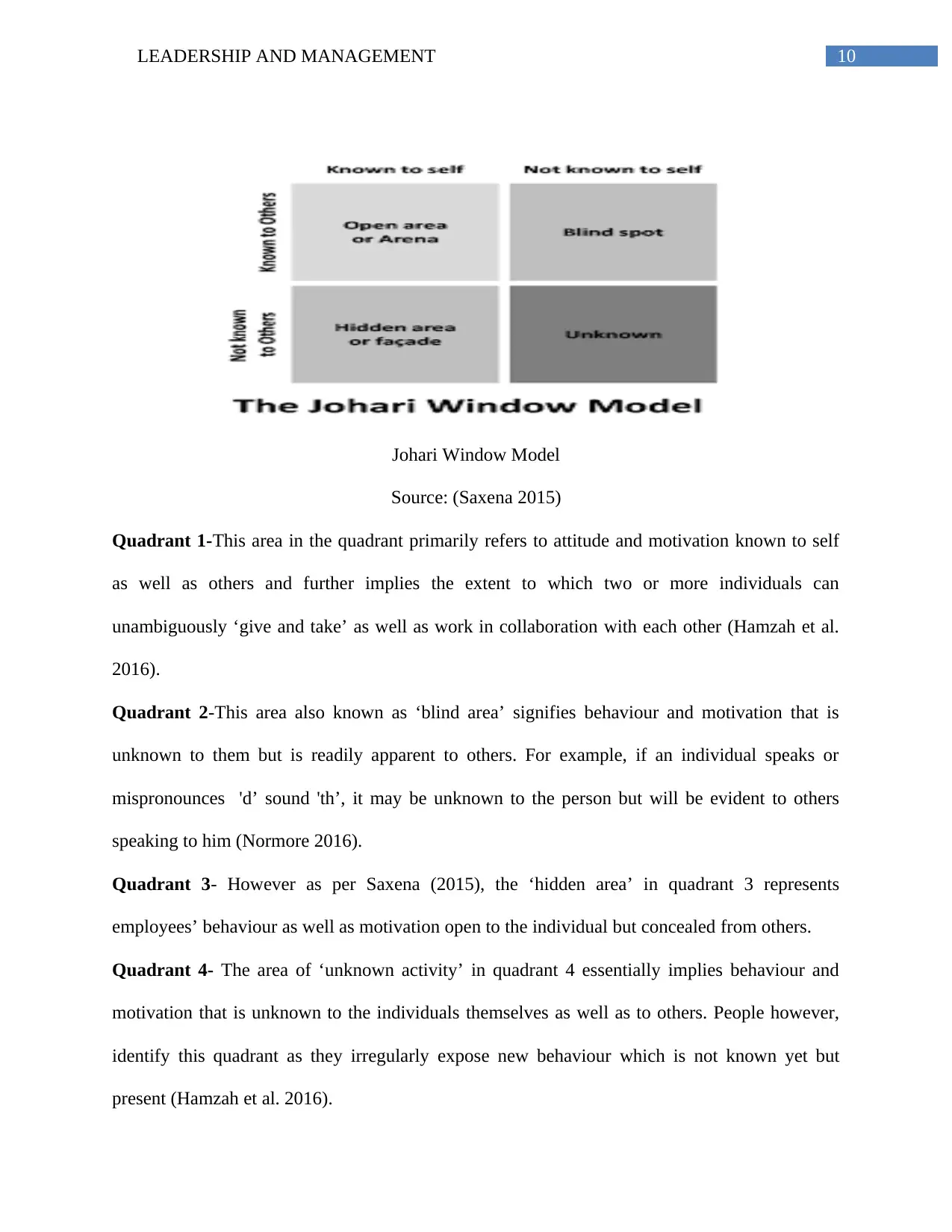
10LEADERSHIP AND MANAGEMENT
Johari Window Model
Source: (Saxena 2015)
Quadrant 1-This area in the quadrant primarily refers to attitude and motivation known to self
as well as others and further implies the extent to which two or more individuals can
unambiguously ‘give and take’ as well as work in collaboration with each other (Hamzah et al.
2016).
Quadrant 2-This area also known as ‘blind area’ signifies behaviour and motivation that is
unknown to them but is readily apparent to others. For example, if an individual speaks or
mispronounces 'd’ sound 'th’, it may be unknown to the person but will be evident to others
speaking to him (Normore 2016).
Quadrant 3- However as per Saxena (2015), the ‘hidden area’ in quadrant 3 represents
employees’ behaviour as well as motivation open to the individual but concealed from others.
Quadrant 4- The area of ‘unknown activity’ in quadrant 4 essentially implies behaviour and
motivation that is unknown to the individuals themselves as well as to others. People however,
identify this quadrant as they irregularly expose new behaviour which is not known yet but
present (Hamzah et al. 2016).
Johari Window Model
Source: (Saxena 2015)
Quadrant 1-This area in the quadrant primarily refers to attitude and motivation known to self
as well as others and further implies the extent to which two or more individuals can
unambiguously ‘give and take’ as well as work in collaboration with each other (Hamzah et al.
2016).
Quadrant 2-This area also known as ‘blind area’ signifies behaviour and motivation that is
unknown to them but is readily apparent to others. For example, if an individual speaks or
mispronounces 'd’ sound 'th’, it may be unknown to the person but will be evident to others
speaking to him (Normore 2016).
Quadrant 3- However as per Saxena (2015), the ‘hidden area’ in quadrant 3 represents
employees’ behaviour as well as motivation open to the individual but concealed from others.
Quadrant 4- The area of ‘unknown activity’ in quadrant 4 essentially implies behaviour and
motivation that is unknown to the individuals themselves as well as to others. People however,
identify this quadrant as they irregularly expose new behaviour which is not known yet but
present (Hamzah et al. 2016).
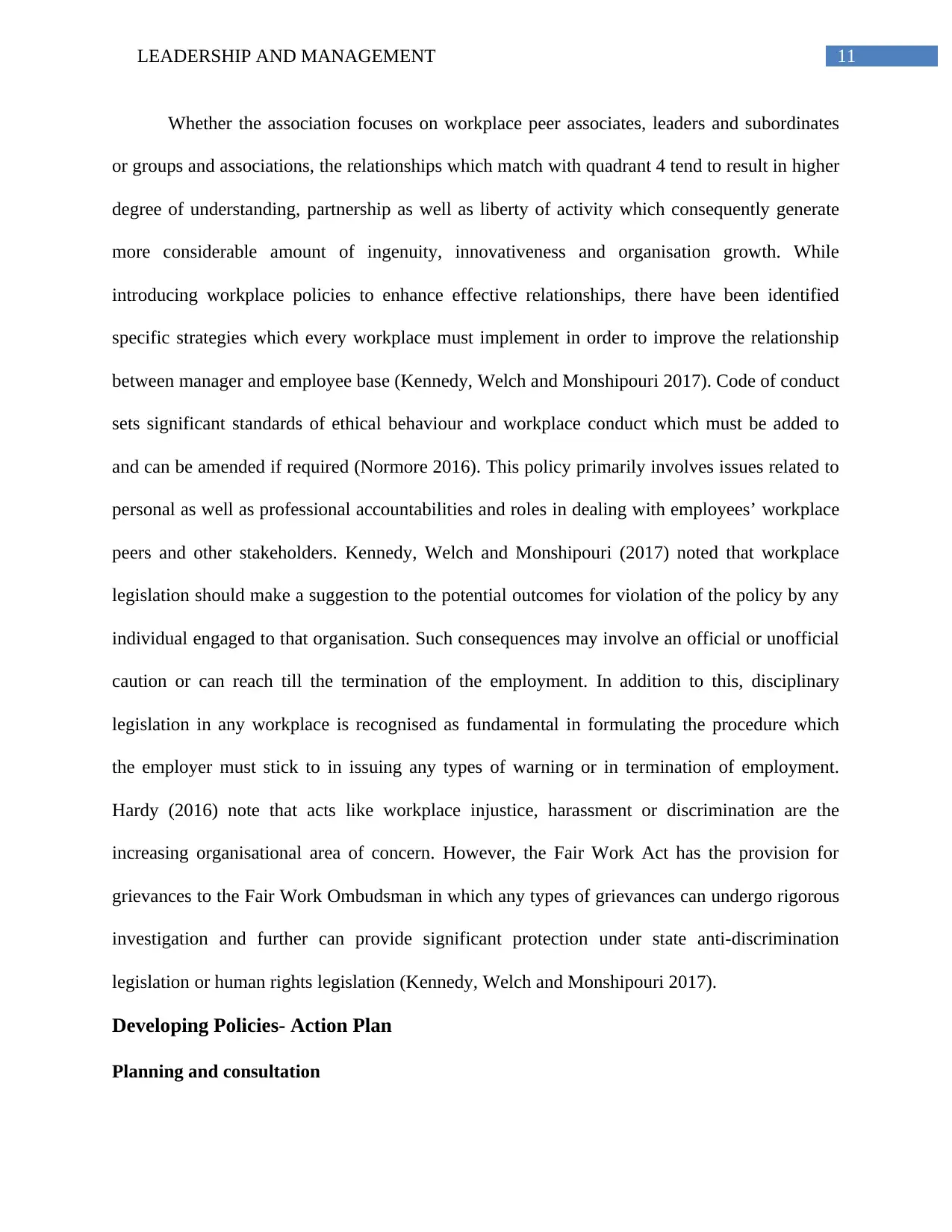
11LEADERSHIP AND MANAGEMENT
Whether the association focuses on workplace peer associates, leaders and subordinates
or groups and associations, the relationships which match with quadrant 4 tend to result in higher
degree of understanding, partnership as well as liberty of activity which consequently generate
more considerable amount of ingenuity, innovativeness and organisation growth. While
introducing workplace policies to enhance effective relationships, there have been identified
specific strategies which every workplace must implement in order to improve the relationship
between manager and employee base (Kennedy, Welch and Monshipouri 2017). Code of conduct
sets significant standards of ethical behaviour and workplace conduct which must be added to
and can be amended if required (Normore 2016). This policy primarily involves issues related to
personal as well as professional accountabilities and roles in dealing with employees’ workplace
peers and other stakeholders. Kennedy, Welch and Monshipouri (2017) noted that workplace
legislation should make a suggestion to the potential outcomes for violation of the policy by any
individual engaged to that organisation. Such consequences may involve an official or unofficial
caution or can reach till the termination of the employment. In addition to this, disciplinary
legislation in any workplace is recognised as fundamental in formulating the procedure which
the employer must stick to in issuing any types of warning or in termination of employment.
Hardy (2016) note that acts like workplace injustice, harassment or discrimination are the
increasing organisational area of concern. However, the Fair Work Act has the provision for
grievances to the Fair Work Ombudsman in which any types of grievances can undergo rigorous
investigation and further can provide significant protection under state anti-discrimination
legislation or human rights legislation (Kennedy, Welch and Monshipouri 2017).
Developing Policies- Action Plan
Planning and consultation
Whether the association focuses on workplace peer associates, leaders and subordinates
or groups and associations, the relationships which match with quadrant 4 tend to result in higher
degree of understanding, partnership as well as liberty of activity which consequently generate
more considerable amount of ingenuity, innovativeness and organisation growth. While
introducing workplace policies to enhance effective relationships, there have been identified
specific strategies which every workplace must implement in order to improve the relationship
between manager and employee base (Kennedy, Welch and Monshipouri 2017). Code of conduct
sets significant standards of ethical behaviour and workplace conduct which must be added to
and can be amended if required (Normore 2016). This policy primarily involves issues related to
personal as well as professional accountabilities and roles in dealing with employees’ workplace
peers and other stakeholders. Kennedy, Welch and Monshipouri (2017) noted that workplace
legislation should make a suggestion to the potential outcomes for violation of the policy by any
individual engaged to that organisation. Such consequences may involve an official or unofficial
caution or can reach till the termination of the employment. In addition to this, disciplinary
legislation in any workplace is recognised as fundamental in formulating the procedure which
the employer must stick to in issuing any types of warning or in termination of employment.
Hardy (2016) note that acts like workplace injustice, harassment or discrimination are the
increasing organisational area of concern. However, the Fair Work Act has the provision for
grievances to the Fair Work Ombudsman in which any types of grievances can undergo rigorous
investigation and further can provide significant protection under state anti-discrimination
legislation or human rights legislation (Kennedy, Welch and Monshipouri 2017).
Developing Policies- Action Plan
Planning and consultation
⊘ This is a preview!⊘
Do you want full access?
Subscribe today to unlock all pages.

Trusted by 1+ million students worldwide
1 out of 17
Related Documents
Your All-in-One AI-Powered Toolkit for Academic Success.
+13062052269
info@desklib.com
Available 24*7 on WhatsApp / Email
![[object Object]](/_next/static/media/star-bottom.7253800d.svg)
Unlock your academic potential
Copyright © 2020–2025 A2Z Services. All Rights Reserved. Developed and managed by ZUCOL.





